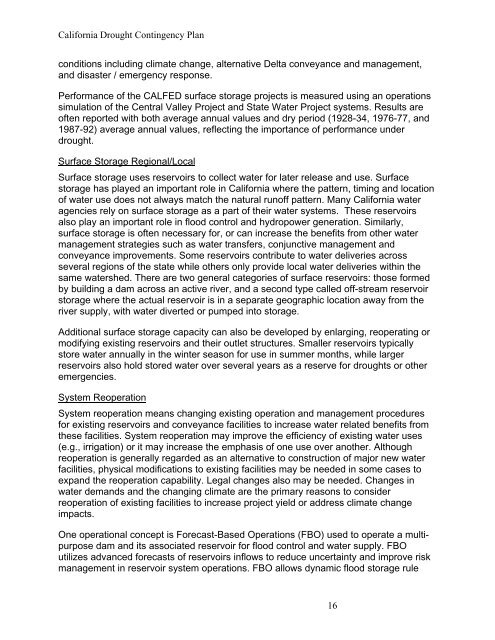Final_CA_Drought_Contingency_Plan-11-18-2010a
Final_CA_Drought_Contingency_Plan-11-18-2010a
Final_CA_Drought_Contingency_Plan-11-18-2010a
Create successful ePaper yourself
Turn your PDF publications into a flip-book with our unique Google optimized e-Paper software.
California <strong>Drought</strong> <strong>Contingency</strong> <strong>Plan</strong>conditions including climate change, alternative Delta conveyance and management,and disaster / emergency response.Performance of the <strong>CA</strong>LFED surface storage projects is measured using an operationssimulation of the Central Valley Project and State Water Project systems. Results areoften reported with both average annual values and dry period (1928-34, 1976-77, and1987-92) average annual values, reflecting the importance of performance underdrought.Surface Storage Regional/LocalSurface storage uses reservoirs to collect water for later release and use. Surfacestorage has played an important role in California where the pattern, timing and locationof water use does not always match the natural runoff pattern. Many California wateragencies rely on surface storage as a part of their water systems. These reservoirsalso play an important role in flood control and hydropower generation. Similarly,surface storage is often necessary for, or can increase the benefits from other watermanagement strategies such as water transfers, conjunctive management andconveyance improvements. Some reservoirs contribute to water deliveries acrossseveral regions of the state while others only provide local water deliveries within thesame watershed. There are two general categories of surface reservoirs: those formedby building a dam across an active river, and a second type called off-stream reservoirstorage where the actual reservoir is in a separate geographic location away from theriver supply, with water diverted or pumped into storage.Additional surface storage capacity can also be developed by enlarging, reoperating ormodifying existing reservoirs and their outlet structures. Smaller reservoirs typicallystore water annually in the winter season for use in summer months, while largerreservoirs also hold stored water over several years as a reserve for droughts or otheremergencies.System ReoperationSystem reoperation means changing existing operation and management proceduresfor existing reservoirs and conveyance facilities to increase water related benefits fromthese facilities. System reoperation may improve the efficiency of existing water uses(e.g., irrigation) or it may increase the emphasis of one use over another. Althoughreoperation is generally regarded as an alternative to construction of major new waterfacilities, physical modifications to existing facilities may be needed in some cases toexpand the reoperation capability. Legal changes also may be needed. Changes inwater demands and the changing climate are the primary reasons to considerreoperation of existing facilities to increase project yield or address climate changeimpacts.One operational concept is Forecast-Based Operations (FBO) used to operate a multipurposedam and its associated reservoir for flood control and water supply. FBOutilizes advanced forecasts of reservoirs inflows to reduce uncertainty and improve riskmanagement in reservoir system operations. FBO allows dynamic flood storage rule16






